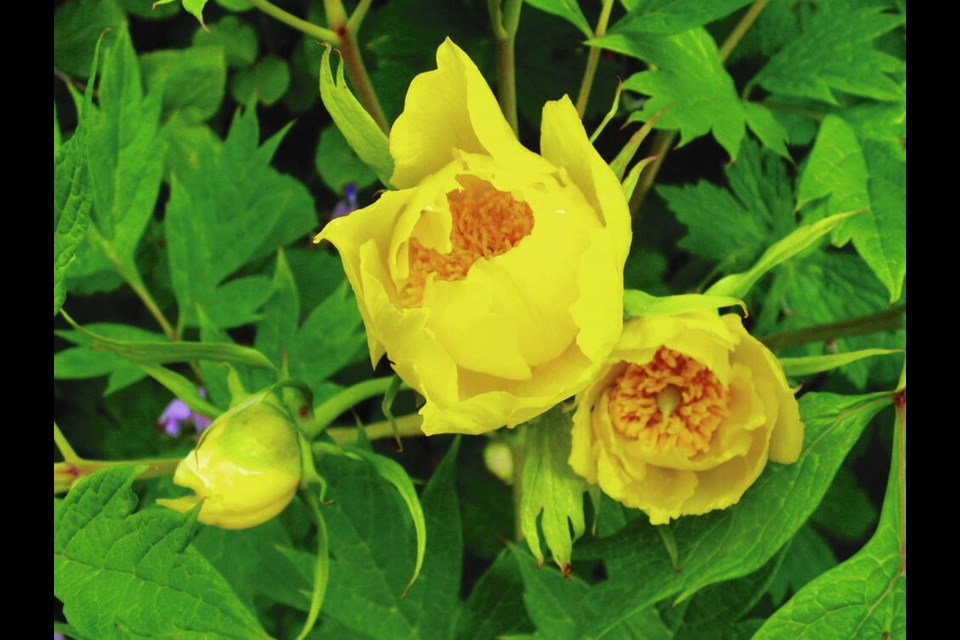Dear Helen: Roots from the neighbours’ cedar hedge are invading our newly acquired garden. Is there anything I can do to eliminate this problem?
W.C.
How you manage the situation will depend on how far the roots have grown into your property, the thickness of the root mass, and your relationship with the neighbours.
If they are not already doing this, encourage them to keep the hedge clipped back to a neat shape and to a modest height. This will at least help to keep the roots to below rampaging mode.
Use a shovel to check how far (in distance) the roots have grown into the soil of your garden. Assess at what point of their intrusion they are easily diggable.
A lane of at least modest width along your side of the hedge should be left alone. Digging right beside the hedge could cause harm to the cedars. That “laneway” left empty could serve as a path that could be cleared and covered with weed-suppressing cardboard and/or thick sheets of newspaper topped with wood shavings or some other material that you find attractive.
If you strongly desire plantings along your side of the hedge, leave at least a modest distance, of 15 to 20 cm, between the hedge base and your plants. Choose tough plants that, once established, will withstand competition from the hedge roots.
In my garden, where cedar roots abound, the most stalwart plants have been epimedium (bishop’s hat) and Geranium macrorrhizum (bigroot geranium), along with the native plants Oregon grape, salal and sword fern. Some of the ornamental grasses are also strong, enduring plants.
If you choose to use plants near the hedge, prepare pockets of soil for them first, by amending the soil with a nourishing compost and a slow-release fertilizer. Keep the ground regularly watered while the plants establish themselves over their first year in the garden.
A third option, if there is a really wide swath of dense root growth from the hedge, would be to clean, weed-proof and cover the space with some attractive material, and use it to display plants in pots.
Dear Helen: In February, squirrels invaded my large pots and ate all the tulip bulbs. Do you have any tips on dealing with these creatures?
P.C.
I had the same experience with my potted tulips, all lined up neatly on shelving against a house wall a few winters ago. Even with almost no space between the pot rims and an upper shelf, squirrels managed to dig out and make away with all the bulbs.
After that, I placed freshly potted tulips in a closed, unheated shed or an unheated store room off the carport. There they stay, with only an occasional light watering, until the first nubs of green growth nudge through the soil surface. At that point, I bring them to their spring display areas. I’ve never had squirrels bother the bulbs at that point.
In the garden, the surest ways to keep squirrels away from plantings of interest to them are physical barriers like fine mesh bird netting, chicken wire and lightweight row covers.
Dear Helen: For many years I ordered seeds of British vegetable varieties, annual and perennial flowers, and shrubs that I could not find anywhere else, from Chiltern Seeds in England. Then the catalogues stopped coming. Have you any information about accessing the catalogue and whether they still send seeds to Canada?
D.G.
I had the same experience. Currently, Chiltern Seeds are sending printed catalogues overseas only by request. Because the postage has become so expensive, they want to send catalogues only to customers who are seriously interested.
To acquire a copy, send a brief email to [email protected]. They will request a catalogue for you.
Some of my best shrubs and perennials have been grown from Chiltern Seeds. Another excellent source for unusual species and cultivated varieties is Plant World Seeds in Devon, England. Their website (plant-world-seeds.com) is wonderfully navigable, with a “Seed by Genus” list that gives plant names in alphabetical order.
That’s where I found that they still offer seeds of the dwarf lavender called “Muffet’s Children” and the beautiful yellow-flowered tree peony in my garden: Paeonia lutea ssp. ludlowii. Like Chiltern Seeds, Plant World lists an extensive selection of vegetables. Plant World lists the superlative Lady Di runner bean.



